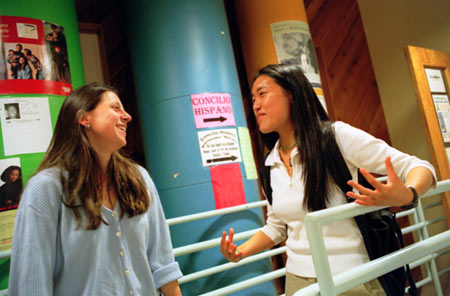Getting fluent in community service
Students in ‘Spanish 38’ learn more than just a language

Eileen Chang ’04, a history and literature concentrator in Quincy House, is committed to improving the Spanish she has studied since she was in junior high school.
Concilio Hispano, a Latino service agency in Cambridge’s Central Square, wants to launch a parents’ group but needs some background research.
As the school year winds to a close, Chang’s Spanish is in top form and Concilio Hispano knows a lot more about Latino parents across Cambridge.
This win-win scenario is the result of a new course called “Spanish 38: Spanish and the Community,” which places students in Latino service agencies for field work, immersing them in the experience of Latinos in the United States while giving their Spanish language skills a workout.
“It was hands-on, real experience surrounding issues of bilingualism, adaptation to North American culture and to institutions,” said Chang of her field placement. Working five hours each week at Concilio Hispano, she crafted a questionnaire for parents about their experience with their children’s school system, translated it into Spanish, and then surveyed them on the phone.
“What surprised me was that so many of the parents that I talked to were very proactive” in their involvement with their children’s education, she said. “But I think those people came to the United States wanting a better life for their children.”
Academics meet community service
Johanna Damgaard Liander, senior preceptor in Romance Languages and Literatures, developed Spanish 38 with help from the David Rockefeller Center for Latin American Studies (DRCLAS), which awarded her and teaching assistant Maria Luisa Parra de Leroux a curriculum development grant. One of just two service learning courses in the College curriculum, Spanish 38 is something of a maverick in its use of the community as a supplementary textbook.
Yet it’s not an entirely new concept, said Liander, who was a Harvard undergraduate in the 1970s. In that decade, “Spanish 95: Community Fieldwork in Spanish” placed students in social service agencies to work in Spanish with Latino families and groups.
In Spanish 38, the experiential learning of field placements is just one way that students learn about the experience of Latin Americans in the United States. Readings, films, and class discussions complement their field placements, making the time commitment to the course a serious one.
“The academic solidity of this course is extremely important,” said Liander, noting that the course teaches toward twin goals. “Not only do we want their Spanish to improve, we want them to learn about the Latino community.”
While their service work, by its nature, introduces the course’s 11 students to the many struggles Latinos face, Parra de Leroux has facilitated classroom conversations with guests who represent the breadth of Latin Americans in this country.
Showing that not all Latinos are struggling, an Argentinean woman who is an assistant professor at Tufts spoke about preserving her language and culture with her children. A successful Guatemalan described her assimilation into American culture, telling the students she has no desire to return to Guatemala.
Project that wouldn’t have happened
Concilio Hispano’s office is just over a mile from Harvard Square, but its location on a side street across from a housing project on the far side of Central Square seems a far cry from Harvard Yard.
As the semester drew to a close, Chang met with her supervisor there, youth development services director Antoinette Basualdo, to present the results of her work and review her project.
The survey put Chang at the center of an issue that’s a primary concern for many Latinos: the education of their children and their opportunities for a better life.
Chang and Basualdo discussed the barriers that prevented parents from being informed and involved in their children’s education. Time was a big one, Chang reported, with some of the Latinos she spoke to working several jobs to support their families. Educational background and confidence with English were other indicators of parental involvement.
Basualdo, whose organization is one of six in Greater Boston that had Spanish 38 volunteers, is eager to move forward with the results of Chang’s survey.
“This is a project that wouldn’t have gotten done in the near future if it weren’t for Eileen,” she said.
‘This is too good to be true’
Liander will offer Spanish 38 in the fall and the spring of next year, after another DRCLAS grant helps her and Parra de Leroux continue to fine-tune the course. Calling this inaugural semester “a work in progress,” Liander thinks the idea of service learning has potential for expansion.
“A lot of students expressed ‘this is too good to be true,’” she said, adding that more than double the number of enrolled students showed interest in the class. She hopes that her course will be a model for other language courses: Other large immigrant groups in the Boston area could provide a similar experience for classes in Portuguese or Russian, for example.
For Chang, her field placement at Concilio Hispano enhanced her classroom work. Translating her surveys into Spanish helped her with the nuances of language, and conducting the surveys introduced her to new phrases and colloquialisms.
“It was really educational for me,” said Chang. “It was more of a realistic look at issues that are going on with Latinos in the United States.”




